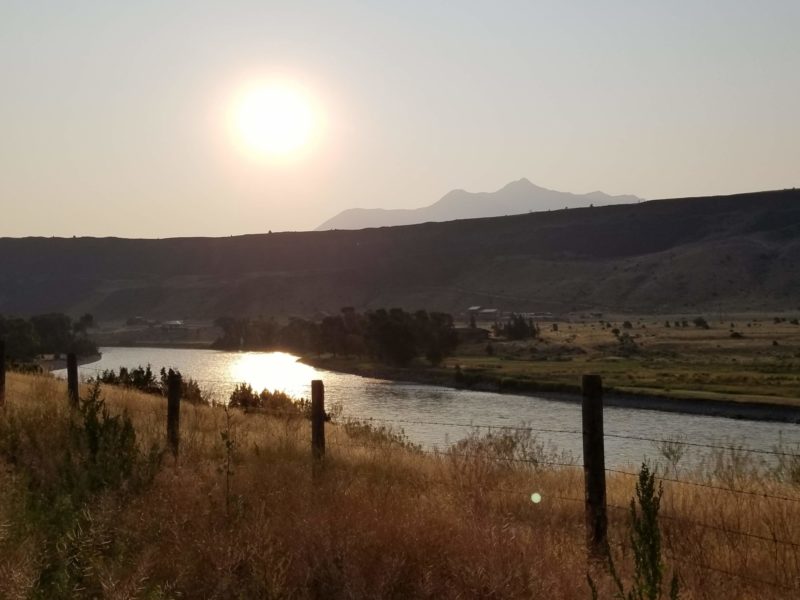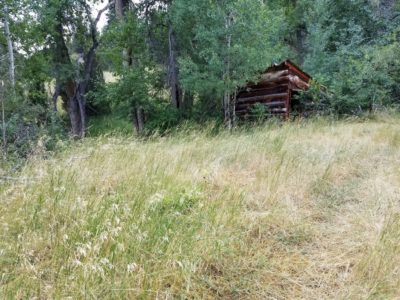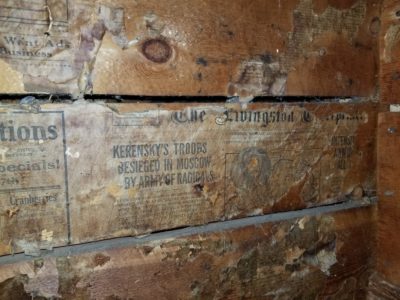Evidence of things not seen
15 March 2019 – Priya Chhaya
Where I am at home, only the sparsest stars
Arrive at twilight, and then after some effort.
And they are wan, dulled by much travelling.
The smaller and more timid never arrive at all
But stay, sitting far out, in their own dust.
They are orphans. I cannot see them. They are lost.
But tonight they have discovered this river with no trouble,
They are scrubbed and self-assured as the great planets.
Sylvia Plath, “Stars Over the Dordogne”
There was a fire. The warmth a contrast with the cool Montana air. As the sun dipped beyond the mountains and dusk passed its way into the deep inky blackness of night, we glanced up to see a sight not often visible from my home in the suburbs of Washington, DC. From my perch on my balcony, I can often only spot one or two sparks of starlight; whereas, on this night, a vast dream of glitter, obscured a little by forest fire smoke from the west, lay above us.

Montana sky (The haziness is due to a series of western forest fires in the summer of 2018.) Photo credit: Priya Chhaya
This past summer I had the opportunity to attend a strategic planning retreat at the West Creek Ranch in Montana, thanks to the generosity of the Arthur M. Blank Family Foundation. At one of the opening events, I was asked to choose a reading—something to set the stage—for the discussions to come. In order to lay out a narrative of contrasts, I chose three readings (Plath’s poetry quoted above and two other pieces, which are excerpted below) that highlighted the challenges we face as purveyors and protectors of the past. These selections provided a throughline for our discussions about preservation in the city, which took place in a very un-city-like environment.
Since that moment last July, I have wanted to extend my thoughts on these pieces further. With the passage of time, I’ve realized that the selections remind me of my own challenges, biases, and expectations. Collectively, they illustrate what I choose to acknowledge, understand, and learn about, and consequently what my limitations might be and how I can work to push through them to be a more effective public historian.
The second reading came from Michel-Rolph Trouillot’s Silencing the Past: Power and the Production of History:
The materiality of [the moment of history creation] is so obvious that some of us take it for granted. It does not imply that facts are meaningless objects waiting to be discovered under some timeless seal but rather, more modestly, that history begins with bodies and artifacts: living brains, fossils, texts, buildings.
The bigger the material mass, the more easily it entraps us: mass graves and pyramids bring history closer while they make us feel small. A castle, a fort, a battlefield, a church, all these things bigger than we that we infuse with the reality of past lives, seam to speak of an immensity of which we know little except that we are a part of it. Too solid to be unmarked, too conspicuous to be candid, they embody the ambiguities of history. They give us the power to touch it, but not that to hold it firmly in our hands—hence the mystery of their battered walls. We suspect that their concreteness hides secrets so deep that no revelation may fully dissipate their silences. We imagine the lives under the mortar, but how do we recognize the end of a bottomless silence?
Trouillot had a profound impact on my understanding of historical practice. During graduate school, Silencing the Past underscored that the history we know is limited in scope. The past, as I understood it, was merely a slice of events and moments in time. In other words, the past we know is equivalent to sitting on my balcony and seeing only a fraction of the stars in the universe. Even though we know the stories are there, we lack the tools with which to see them with more clarity.

View of one of the structures that dotted the landscape along a hiking trail at the West Creek Ranch. Photo credit: Priya Chhaya
In the passage above, Trouillot outlines this challenge by emphasizing the power of history’s material culture. In my interpretation, he reveals how in focusing on the evidence that we can see—that we have already collected—we miss that which is hidden below.
But even that analysis requires a challenge.
The title of this post comes from an episode of The West Wing (though it is also the name of a James Baldwin essay collection, and is a Bible verse). In the show, the phrase (“evidence of things not seen”) has to do with standing an egg on its head during the vernal equinox (or something like that); for our purposes, it lends itself to a discussion of important work being done in the field.
For a long time, the work of practicing historians was tied to particular types of evidence: primary sources, including texts and material culture, that told us about how people thought, acted, and behaved. These documents—that listed people as property or only acknowledged important men at critical moments—limited our view and understanding of all of the actors in the past.
Mining and analyzing evidence of things not seen: That is the task of inclusion. Piecing together underrepresented histories. For some this task is a seeming impossibility, and provides cover for not pushing for change, i.e. “The evidence does not exist, and therefore we cannot tell this story.”
For others, this problem is an obfuscation. The evidence does exist, but has been silenced due to a variety of issues, including the vagaries of the publishing industry, archival access, challenging societal circumstances, and the dominance of interpretations that were made long before our current framework of understanding.
It is also a matter of embracing non-traditional types of evidence. Evidence that gives voice to those who did not have the power of the pen or the power that comes with owning property. It requires paying attention to other tools for conveying historical ideas and narratives, including oral tradition, intangible practices, and the arts.

Interior of a shack at the West Creek Ranch. You can see newspaper lining the walls—this one from 1927. Photo credit: Priya Chhaya
Believing in the evidence of things not seen is merely another way of asking historians to observe how these stories are manifested in the cultural practices and beliefs of people today.
And now the third reading, from Dolores Hayden’s The Power of Place: Urban Landscapes as Public History:
On the ways in which social history is embedded in urban landscapes:
This subject needs to be grounded in both the aesthetics of experiencing places with all five senses and the politics of experiencing places as contested territory [emphasis mine]. Much the same can be said for organizations of historians, preservationists, or environmentalists, or of individual artists and designers who wish to use the social history of places to make more resonant connections to public memory.
Places make memories cohere in complex ways. People’s experiences of the urban landscape intertwine the sense of place and the politics of space. If people’s attachments to places are material, social, and imaginative, then these are necessary dimensions of new projects to extend public history into the urban landscape as well as new histories of American cultural landscapes and the buildings within them.
If Plath is urging us to see beyond our own perspective, and Trouillot sought to pull forward that which had been silenced, then this excerpt from Hayden’s The Power of Place asks us to consider the role of politics and power in building these new narratives.

Shadows at the entrance to the West Creek Ranch. Photo credit: Priya Chhaya
How much of what we need to tell the full story is limited by power? The power of governments and money; the power of old definitions of what is historic and worthy of being preserved? How do we look at what Hayden calls contested territory and not only side with those whose struggles have long since been pushed aside, but also acknowledge the way power has been used to further diminish that very real past?
It is important to remember that in most cases this is not our history to tell. The evidence is there in the hearts, minds, and experiences of people living today. For public historians, it is important to find the balance between our role as professionals and our roles as stewards of the past.
And so, perhaps, the practice of history today is closer to Plath’s final lines in her poem:
What if the sky here is no different,
And it is my eyes that have been sharpening themselves?
~ Priya Chhaya is the associate director of publications and programs at the National Trust for Historic Preservation, You can learn more about her work at www.priyachhaya.com or follow her on Twitter/IG @priyastoric.




“How do we look at what Hayden calls contested territory and not only side with those whose struggles have long since been pushed aside, but also acknowledge the way power has been used to further diminish that very real past?” This is precisely why I have students read Howard Zinn’s ‘ ℎ .
Ooh! I love this! You know I love talking about the silences and how to listen to what they are telling us, and ways through and around them. Thank you so much for these insights, Priya!